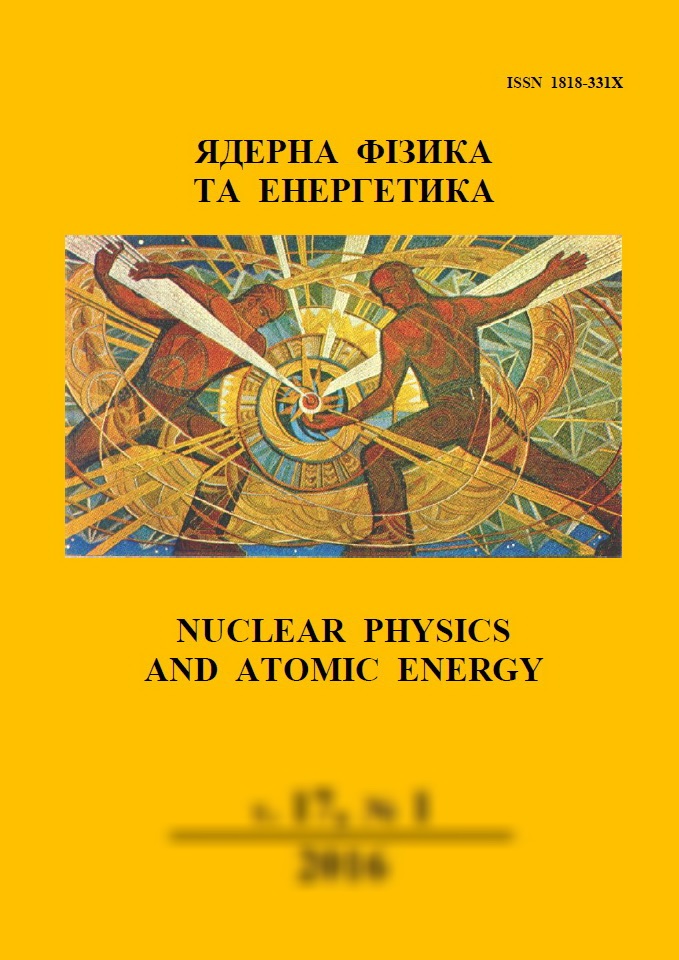 |
Ядерна фізика та енергетика
Nuclear Physics and Atomic Energy
ISSN:
1818-331X (Print), 2074-0565 (Online)
Publisher:
Institute for Nuclear Research of the National Academy of Sciences of Ukraine
Languages:
Ukrainian, English
Periodicity:
4 times per year
Open access peer reviewed journal
|
Nucl. Phys. At. Energy 2002, volume 3, issue 1, pages 28-33.
Section: Nuclear Physics.
Received: 15.11.2001; Published online: 30.03.2002.
 Full text (ru)
Full text (ru)
https://doi.org/10.15407/jnpae2002.01.028
Effective probabilities method for heavy-ion elastic scattering angular distribution analysis
Yu. A. Pozdnyakov1
1Institute for Nuclear Research, National Academy of Sciences of Ukraine, Kyiv, Ukraine
Abstract:
Previously proposed the new approach to heavy-ion elastic scattering angular distributions analysis
is generalized for the cases when the total (i.e. summed over all channels) partial probabilities of "fusion" (in
general complete and incomplete fusion, quasifission and deep inelastic collisions) enhancement are
comparable with total partial probabilities of "fusion" hindrance. It became possible due to effective total
partial probabilities introduction, every of which is a linear combination of either actual total partial
probabilities. It is shown that introduced in such manner probabilities have quite definite physical meaning.
Really, effective total partial probabilities allow to calculate entrance channel "fusion" cross section and
certain reference peripheral processes cross section, comparison with which calculated or measured
correspondingly "fusion" or total peripheral reaction cross section allows one to predetermine about "fusion"
or peripheral reactions enhancement or hindrance. It is also established that "fusion" enhancement is
accompanied by peripheral reactions hindrance, and vice versa.
References:
1. Поздняков Ю. А., Теренецкий К. О. Збірник наукових праць Інституту ядерних досліджень 2 (2001) 31.
https://jnpae.kinr.kyiv.ua/02.1/Articles_PDF/jnpae-2001-02-1-031.pdf
2. Sakuragi Y. Phys. Rev. C 35 (1987) 2161.
https://doi.org/10.1103/PhysRevC.35.2161
3. Signorini C., Andrighetto A., Ruan M. et al. Phys. Rev. C 61 (2000) 061603(R).
https://doi.org/10.1103/PhysRevC.61.061603
4. Satchler G. R., Love W. G. Phys. Rep. 55 (1979) 183.
https://doi.org/10.1016/0370-1573(79)90081-4
5. Strutinsky V. М. Nucl. Phys. 68 (1965) 221.
https://doi.org/10.1016/0029-5582(65)90381-0
6. Rawitscher G. H. Nucl. Phys. 85 (1966) 337.
https://doi.org/10.1016/0029-5582(66)90629-8
7. Eisen Y., Vager Z. Nucl. Phys. A 187 (1972) 219.
https://doi.org/10.1016/0375-9474(72)90085-1
8. Вербицкий В. П., Ильин А. П., Поздняков Ю. А., Теренецкий К. О. Изв. АН СССР. Сер. физ. 49 (1985) 945.
9. Vaz L. C., Alexander J. M., Satchler G. R. Phys. Rep. 69 (1981) 373.
https://doi.org/10.1016/0370-1573(81)90094-6
10. Beckerman M. Phys. Rep. 129 (1985) 145.
https://doi.org/10.1016/0370-1573(85)90058-4
